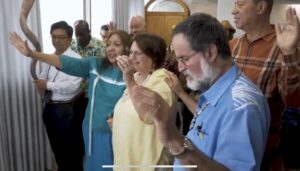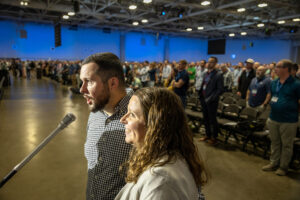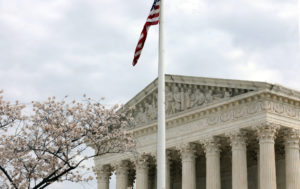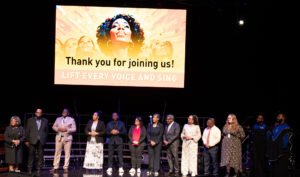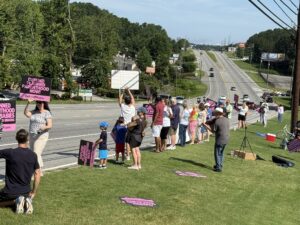
 A recent study by LifeWay Research found that, though the national economy shows signs of improving, the economic state of many of our cooperating churches continues to face challenges. The status of church financial health has a direct impact on the strength and viability of the Cooperative Program. The Cooperative Program is not a "top-down" funding mechanism that begins at the national Convention; rather, it is a "trickle down" pool of resources that comes from cooperating churches to help fund the ministries that have been adopted by the messengers — elected by the churches — who attend the annual meeting of the Southern Baptist Convention.
A recent study by LifeWay Research found that, though the national economy shows signs of improving, the economic state of many of our cooperating churches continues to face challenges. The status of church financial health has a direct impact on the strength and viability of the Cooperative Program. The Cooperative Program is not a "top-down" funding mechanism that begins at the national Convention; rather, it is a "trickle down" pool of resources that comes from cooperating churches to help fund the ministries that have been adopted by the messengers — elected by the churches — who attend the annual meeting of the Southern Baptist Convention.
The Trickle-Down Effect of the Cooperative Program
At its heart, the Southern Baptist Convention promotes a set of aggressive, Kingdom-focused, and Kingdom-sized ministry objectives, funded by cooperating churches. Unlike local churches that are able to make direct, weekly appeals to their membership, the Southern Baptist Convention merely receives what churches determine to forward to its ministries. While the Convention is charged to promote the Cooperative Program by making appeals to its cooperating churches, the Convention does not make direct appeals to church members for contributions. The Convention is dependent on the results achieved by church leaders making the ministry needs of the Convention known to their respective members.
State conventions receive the first-share distribution of CP funds from the churches. Messengers from contributing churches in each state convention set annual budgets for the states. These annual budgets include the percentage of Cooperative Program receipts that each state chooses to forward to the national Convention and its ministries.
In Southern Baptist life, the local church is at the top of the pyramid. Authority flows downward from the churches, through their elected messengers, to the state convention. It also flows downward from the churches, through their elected messengers, to the national Convention. The Convention has no authority over any local church. It has no authority over any state convention. It only has authority to engage in those ministries that are created by the messengers and supported by the churches. Thus, the Convention cannot (and does not) tell the local church what it must give. Neither does the Convention tell the state conventions what percentage of Cooperative Program contributions they should forward from the churches in their respective states, although it continues to hold up a 50/50 split as an ideal.
If we could create a visual of how Cooperative Program gifts travel from the local church to the ministries of the SBC, it would look like this:
A vast reservoir is positioned high above the SBC village. It is comprised of almost 45,000 churches, each of which receives tithes and offering from faithful donors. This reservoir amounted to more than $12 billion dollars in total gifts in 2008. Radiating out from each church that surrounds this reservoir are the fertile fields of each local church, watered by the resources in this reservoir.
Underneath this reservoir are scattered forty-two smaller reservoirs called state conventions. Each state convention receives a small amount of water from the churches that contribute to its section of the larger reservoir. On average, each state receives about 6 percent of undesignated receipts that were channeled through the churches. Radiating out from the state convention are the fertile fields of ministry that the messengers of the respective states believe are appropriate for the states to plant and water. Roughly two-thirds of the water received by the states from the churches, or 4 percent of the whole, is used to water these ministries.
Underneath these smaller reservoirs is the small pool that constitutes the Southern Baptist Convention. About 2 percent of the water from the large reservoir, or one-third of the amount forwarded from the churches to the states, trickles into this pool. One-half of the water the Convention receives is channeled directly to the fields watered by the International Mission Board (50 percent of the amount received by the SBC). Almost one-fourth of the water is directed to North American Missions (22.79 percent). Another almost one-fourth (22.16 percent) is channeled to the six SBC seminaries. The remainder is used to water the ERLC, the annual meeting expenses, and the work of the Executive Committee.
Bob Rodgers, vice president for Cooperative Program with the SBC Executive Committee, observed, "The state conventions are composed of the very same churches the SBC is composed of. In a sense, they are us, and we are them. Our viability depends on theirs and vice versa."
The Trickle-Down Impact on the Cooperative Program
The Economy and the Local Churches. According to Ed Stetzer, director of LifeWay Research, "While the national economy shows signs of improving, churches don't seem to be recovering yet and, in fact, might actually be doing a bit worse.
"It's not surprising that churches — and their giving — are more impacted by unemployment than, for example, the stock market or GDP [gross domestic product]," Stetzer said.
More than half of pastors reported higher unemployment in their congregations and nearly a fourth said more people have moved away in search of work. Many more churches reported they had frozen staff salaries for 2009 — 47 percent, in contrast to 35 percent as reported in a similar February 2009 survey.
The Economy and the State Conventions. Most of our cooperating state conventions adopt their respective budgets in the fall. Now that all forty-two state conventions have completed their budget process, it is possible to assess the potential impact on the SBC share of Cooperative Program receipts.
Our cooperating state conventions expect to receive $502 million in Cooperative Program gifts from the churches for 2010. This is down almost $40 million from the previous year. Only a very few states adopted a budget increase for 2010. Most states either froze their budgets at 2009 levels or reduced their budgets to pre-2009 levels. Several states reduced their budgets to levels from three, four, or five years ago.
The Economy and the Southern Baptist Convention. Given that the Cooperative Program is a residually-funded mechanism for funding SBC ministries, it is not immune to these budgetary realities. The messengers to almost every state convention voted to continue forwarding the same percentage of Cooperative Program receipts to the SBC that their states forwarded the previous year. Some states actually voted to increase the percentage that is forwarded to the SBC. However, the net effect is that, given the reduced budget expectations of the state conventions, the SBC will receive significantly less from the states in 2010 than it received in 2009. In a very real way, when the churches suffer financially, the states share in their suffering. When the churches and the states suffer, the SBC shares in their sufferings as well.
The state conventions have shown fiscal prudence and wisdom in adopting budgets more in line with what the historical trend of church contributions to the Cooperative Program shows (down from over 10 percent in 1990 to just over 6 percent in 2008). The SBC also follows a fiscally prudent budgetary process. In any given year, the SBC adopts a budget goal for the following year equal to the previous year's actual receipts. This plan seeks to minimize the financial fall-out sustained when the nation experiences an economic crisis. However, even given fiscal responsibility, no budget process could account for the size and the breadth of the economic melt-down of 2009.
"The economic downturn is forcing many churches to become more volunteer-driven organizations focused on helping the hurting in times of need," Stetzer said. "But churches have not yet joined the broader economic recovery and, historically, they tend to recover financially when unemployment decreases," which has not yet happened, "and usually after the economy as a whole" has recovered.
In analyzing the state convention budgets, the cumulative "trickle-down" impact of church giving takes on immense proportions. Though the churches continue to support the ministries of the Convention, Bob Rodgers observed, "The churches in the SBC have voted, through their respective state conventions, to approve and adopt a giving plan for 2010 that will result in IMB receiving about $8.5 million less from the CP, NAMB will receive about $3.9 million less, the seminaries will receive about $3.7 million less, ERLC will receive about $280 thousand less, and the SBC operating budget can expect to receive about $578 thousand less" than last year.
He further noted, while words like, "consistent, reliable, predictable, cooperative, synergistic, and effective" are words which "describe why Southern Baptists have, down through the years, praised and continued to use the Cooperative Program as its ministry-funding method," the CP is not immune from the continuing economic crisis facing our nation and our world.
The Executive Committee of the SBC is charged to promote biblical stewardship and the Cooperative Program. Noting that the typical churchgoer gives less than 2.5 percent of his or her disposable income to Kingdom work, Rodgers said, "All of us, from time to time, have a tendency to treat the symptoms of a disease rather than the disease itself. We treat symptoms by reprioritizing them, reclassifying them, ignoring them." Sometimes we think that if we create "structure and organizational changes, or even throw money at them," the problems will rectify themselves.
Rodgers observed, "The SBC funding challenges are not procedural or process problems, or problems of the wallet, but are the result of an underlying heart disease. Jesus said, 'Where your treasure is, there your heart will be also.'
"The Convention's solution for its apparent funding challenges in 2010 is to cure this individual and corporate heart disease by allowing God to move the SBC toward biblical stewardship. To this end we continue to work and pray."






